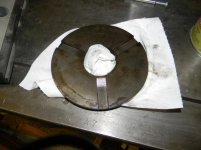My Rambaudi Mill has an electromagnetic brake on the spindle that hasn't worked. The sheave has a steel plate with dogs but the brake wasn't engaging it. Turns out the wires leading into the coil were broken as they entered. Can the coil be repaired and new leads brought out? The brake is a Baruffaldi and replacing will be difficult without swapping sheaves.
View attachment 285603 Coil and plate on machine.
View attachment 285604 Front of coil
View attachment 285605 Back of coil with wires barely in sight. Is this a job for a motor shop? thanks, Dave
If you cut yerself a couple of short lengths of insulating tubing, slip them over the two stub wires, you should be able to get first, meter probes on the pair without shorting to each other or the frame..
- See if you have continuity.
If so..
- go the next step - apply appropriate power and see if you have a strong magnetic field rather than smoke or stink.
IF.. the coil is good, then it is tedious as-in eye surgery to splice-on new leads when those are so hard to get at.
But it CAN be done.
Then sleeved with heat-shrink tubing OR salvaged soft insulation jacketing from larger wire plus liquid tape if yah need more flexibility.
No rewinding needed. Hopefully. Unlesss... a PO CUT the wires because it HAD shorted turns?
BTW: Baruffali is still in bizness, but they were never "cheap", so "spare part" might be a joke.
You might also see if the size is close enough you could adapt a coil - or an entire clutch - from an ag/groundskeeping mower-drive electric clutch.
They are about a hundred bucks, complete, on ePrey, new. Stewart-Warner or Dings motor-brake coils or complete units are another possible source.
"Personally"... I'd be tempted to rig a bellcrank, lever, cable, or rod and make it into a "manual" brake. or simply do without and move on to some other more important project.
It's a mill, not a motor vehicle. Not all of them ever HAD a spindle brake.
 Coil and plate on machine.
Coil and plate on machine. Front of coil
Front of coil Back of coil with wires barely in sight. Is this a job for a motor shop? thanks, Dave
Back of coil with wires barely in sight. Is this a job for a motor shop? thanks, Dave Coil and plate on machine.
Coil and plate on machine. Front of coil
Front of coil Back of coil with wires barely in sight. Is this a job for a motor shop? thanks, Dave
Back of coil with wires barely in sight. Is this a job for a motor shop? thanks, Dave



